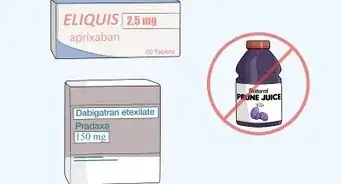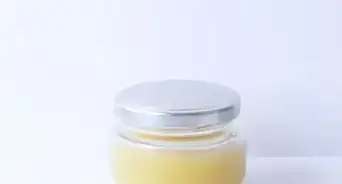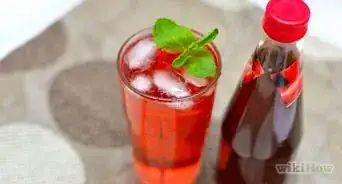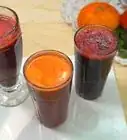This article was co-authored by Ollie George Cigliano. Ollie George Cigliano is a Private Chef, Food Educator, and Owner of Ollie George Cooks, based in Long Beach, California. With over 20 years of experience, she specializes in utilizing fresh, fun ingredients and mixing traditional and innovative cooking techniques. Ollie George holds a BA in Comparative Literature from The University of California, Berkeley, and a Nutrition and Healthy Living Certificate from eCornell University.
There are 7 references cited in this article, which can be found at the bottom of the page.
wikiHow marks an article as reader-approved once it receives enough positive feedback. In this case, several readers have written to tell us that this article was helpful to them, earning it our reader-approved status.
This article has been viewed 72,424 times.
Juicing is the process of separating the juice from the pulp and flesh of fruits and vegetables. When consumed along with whole fruits and vegetables, juices can be a part of a healthy and balanced diet, and are a great way to get more vitamins and minerals into your diet. The basic juicing process is quite simple, and can be done with either a dedicated juicing machine or with a blender and strainer. You can either follow recipes to make your juices, or you can experiment with ingredients to create your own concoctions.
Steps
Using a Juicer
-
1Gather your ingredients and supplies. To make a juice, you'll need fresh produce and something to extract the juice from the fruits and vegetables. A juicing machine is the most convenient way of making juice, because it’s designed to separate the juice from the pulp and flesh.
- If you don’t have a juicer, you can also use a blender to make juice. Once all the fruit and vegetables have been pureed, you can press the smoothie through cheesecloth to extract the juice.
- You can either work from a recipe to make your juice, or you can improvise with some of your favorite fruits and veggies. It’s important to work with fresh produce, because frozen fruits and vegetables won’t juice properly.
-
2Wash your ingredients. It’s important to wash fruits and vegetables with clean running water to remove dirt, bacteria, and other residue.[1] Rinse delicate berries, rub soft fruit and vegetables with your hands, and scrub harder produce with a vegetable brush.
- When your produce is clean, pat it all dry with a clean towel.
Advertisement -
3Remove thick skins and pits. One of the nice things about juicing is that you don’t have to remove thin skins, cores, stems, and other parts that you normally don’t eat. This is because the juicer will separate and remove these parts for you. However, you do have to remove thicker skins, seeds, and pits from certain fruits and vegetables.[2]
- Remove thick skins from fruits like pineapple, mango, papaya, citrus fruits, and melons.
- Remove the pits from fruits like cherries, peaches, nectarines, mangos, and plums.
- Remove shells from any nuts and seeds that you want to juice.
-
4Chop larger fruits and vegetables into smaller chunks. Most juicers are designed to handle large chunks of fruit and vegetable, so some produce can even be left whole. Large and medium produce should be cut into more manageable pieces:
- For large fruits and vegetables, chop them into two inch (five cm) cubes. This includes things like cabbage, pineapple, and watermelon.
- Medium fruits and vegetables, like apples, tomatoes, and beets, should be cut into quarters.
- Small and skinny produce like carrots, celery, asparagus, radishes, berries, and kiwis can be juiced whole.
-
5Assemble the juicer. Juicing machines often come with multiple components. Follow the manufacturer’s instructions to put your juicer together. Most juicers follow a similar assembly process, which includes:
- Fit the juicing bowl into the center of the juicer. This will catch the produce and separate the juice and pulp.
- Insert the auger into the juicing screen and the screen into the holder. Place the assembled component inside the juicing basket.
- Place the lid on the juicer, and position a pitcher or cup beside the spout to catch the juice.[3]
-
6Juice your ingredients. Turn on your juicer. Take a handful of your first ingredient and feed it into the feed chute. Insert the pusher into the chute and press it down all the way to push all the produce through the screen. Remove the pusher and add another small batch of the same ingredient.
- When you’ve finished with your first ingredient, move on to the next.
- As you juice, make sure you adjust the speed setting depending on the type of produce you're juicing. Many juicers have different settings for hard, medium, and soft produce.
-
7Use a blender to make juice instead. To make juice using a blender, combine all the ingredients in the blender. Puree everything together, adding a few splashes of water if you need to loosen the pulp.
- When you’ve blended all the ingredients and there are no large chunks left, pour the smoothie into a cheesecloth or fine-mesh strainer.
- Position the cheesecloth over a bowl or cup and squeeze the cheesecloth to separate the pulp from the juice.
-
8Stir the juice before serving. Once you’ve juiced all your ingredients, remove the cup or pitcher holding the juice. Give the juice a good stir to mix and incorporate all the different juices.
- Serve the juice as is, or chill it for a few hours before serving. You can also serve the juice fresh on ice.
- Refrigerate any unused portions and consume within a couple days.
Choosing Ingredients
-
1Get creative with vegetables. The fiber contained in the flesh of the fruit or vegetable is removed in the juicing process, and this can lead to spikes in your blood sugar when you drink juice. Because vegetables have less sugar than fruits, it’s better to drink juices that are primarily vegetable-based.
- Good vegetables for juicing include carrots, tomatoes, celery, cucumber, spinach, kale, broccoli, beets, cabbage, sweet potatoes, radishes, and peppers.[4]
- Many vegetables make tasty juices, even if you don’t like eating those vegetables whole.
- For slightly sweeter juices, add one or two fruits to your vegetable juices. Fruits like pears and apples will add sweetness without adding a lot of fruit flavor.
-
2Consider a variety of fruits. Juices in the grocery store can be pretty basic, and many people often just see things like orange, grape, cranberry, and apple juice. But you can juice just about any fruit or vegetable you like, and the more variety you eat, the more nutrients you'll get.
- Fruits like kiwis, strawberries, pomegranates, mangoes, papayas, apricots, plums, and peaches are great juicing candidates.
- Bananas, avocados, and other creamy fruits tend to clog juicers.[5] If you want to juice these types of produce, use the a blender to puree the fruit and then strain out the juice.
-
3Add herbs, seeds, and nuts to your juices. Herbs add new flavor and provide additional nutritional benefits to juices. The moisture in seeds and nuts gets converted to creamy substance when the fiber is removed, resulting in a richer juice that's more filling.
- Consider adding a fresh flavor to your juice by incorporating fresh mint, lemon balm, rosemary, basil, dill, or other herbs.
- Wheatgrass is popular with many juice enthusiasts. Be careful with this, though, because the straw-like texture of wheatgrass clogs many conventional juicing machines.
- You can also juice shelled cashews, almonds, sunflower seeds, and many other seeds and nuts. When you juice nuts and seeds, it’s important to soak them overnight to ensure you can extract as much from the meat as possible.[6]
-
4Choose ripe, local produce that's in season. Ripe fruits and vegetables will taste better and have more nutrients than unripe fruit, making your juice better tasting and be more nutritious. Also, seasonal local fruit will have less of an environmental impact than imported fruit.
- Local farmers markets are a great place to get fruits and vegetables for juicing. Many farms also have on-farm markets where you can buy or pick your own produce.
- Both conventional and organic produce may be grown with pesticides, so wash your fruits and vegetables well before juicing.
Following Juicing Recipes
-
1Make a green juice. This juice includes nutritious vegetables that produce a delicious bright green juice. In this recipe, the apple sweetens the juice, the ginger adds a spicy kick, and the lime provides a tangy punch. This juice can easily be made with a juicer or blender, and the ingredients are:
- 1 medium cucumber
- 4 medium kale leaves
- 1 cup cilantro leaves and stems
- 1 large apple
- 1½-inch (3.8-cm) piece of ginger
- 1 lime
- 3 medium celery stalks
-
2Try a tropical fruit juice. Tropical fruits like mango and pineapple can be mixed with other veggies and fruits to create a sweet juice that’s packed with vitamin A and other nutrients. For this recipe, juice or blend together:
- 1 orange
- 1 mango
- 1-inch (2.5-cm) disk of pineapple
- 4 strawberries
- 2 carrots
-
3Whip up a berry and beet juice. This bright red juice can be consumed as is, or frozen to eat as a cool summer treat. You can use any type of combination of berries to suit your tastes or to accommodate what's in season:
- 4 cups of berries, such as blueberries, blackberries, raspberries, or strawberries
- 1 beet
-
4Make your own vegetable juice. Veggie juices are packed with many different types of produce and loads of nutrients. You can drink vegetable juice cold, use it as a soup base, or use it to make cocktails. To make this drink, you'll need:[7]
- 2 to 3 hearts of romaine
- 2 to 3 fresh chives
- 2 large tomatoes
- ¼ fresh jalapeño
- 1 red bell pepper
- 2 large stalks celery
- 1 medium carrot
-
5Try a refreshing cucumber drink. The base of this juice is cantaloupe and cucumber, making it a cool juice that’s great for hot summer afternoons. You can even freeze the juice in ice cube trays and use it to chill and flavor your water. For this juice, you'll need:[8]
- ¼ ripe cantaloupe
- 2 stalks celery
- ½ cucumber
- ¼ lemon
Community Q&A
-
QuestionWhy does fruit turn brown after it's cut?
 Community AnswerWhen you cut into a piece of fruit, you damage the cells. This bruising leads to the creation of an enzyme called polyphenol oxidases, which reacts with oxygen. When polyphenol oxidases mixes with oxygen, it creates the browning effect. You can slow this process down by coating cut fruit with sugar, syrup, or citrus juice.
Community AnswerWhen you cut into a piece of fruit, you damage the cells. This bruising leads to the creation of an enzyme called polyphenol oxidases, which reacts with oxygen. When polyphenol oxidases mixes with oxygen, it creates the browning effect. You can slow this process down by coating cut fruit with sugar, syrup, or citrus juice. -
QuestionHow do I make apple juice?
 EllieCommunity AnswerWe have an article about that! Check out How to Make Apple Juice for the instructions.
EllieCommunity AnswerWe have an article about that! Check out How to Make Apple Juice for the instructions.
References
- ↑ http://www.theguardian.com/lifeandstyle/2011/nov/07/dr-dillner-wash-fruit-vegetables
- ↑ http://www.rebootwithjoe.com/juicing/produce-prep/
- ↑ https://www.youtube.com/watch?v=idIr6QPfwm4
- ↑ http://www.rebootwithjoe.com/juicing/produce-prep/
- ↑ http://www.sheknows.com/food-and-recipes/articles/809255/how-to-use-your-juicer
- ↑ http://www.101cookbooks.com/archives/a-lesson-in-juicing-recipe.html
- ↑ http://www.eatingwell.com/recipe/252667/tomato-vegetable-juice/
- ↑ http://wholefully.com/2016/05/24/8-easy-juice-recipes-to-get-you-started-juicing/
About This Article
If you want to make juice with a blender, start by getting some fresh fruit and vegetables, and avoid frozen produce, since it doesn't juice well. Wash your produce with running water, pat them dry, then remove skins, pits, and any other parts you don't eat. Next, chop your fruits and vegetables into smaller pieces that the blender can handle before pureeing everything at once. If the pulp is a little too thick, try adding a bit of water. Continue blending until there are no big chunks, then pour the juice through a strainer, stir, and serve. If you want to learn different juice recipes that you can try, keep reading the article!





















































